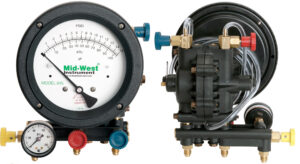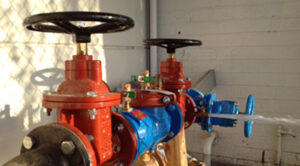Backflow Testing NYC helps protect the water supply from contaminants. It’s required in properties where chemicals, bacteria, or other dangerous substances may flow into the freshwater supply.

Backflow tests examine several different aspects of your plumbing system. These include pressure imbalances, valves, and back-siphonage. These tests should be done annually to keep your family safe from backflow contamination.
If you have a backflow preventer on your sprinkler system or fire protection line, it needs to be tested each year. This test ensures that the device is working properly and that dirty water won’t backflow into clean drinking water in your home. It’s also a great way to catch imbalances in water pressure before they become major problems. Backflow Testing isn’t a complicated process and can be handled by most plumbers or HVAC technicians who have the right equipment.
Backflow Testing isn’t just important for homeowners, but also for business owners who use sprinkler systems for their landscaping or irrigation purposes. These types of systems can cause dirty water to backflow into the public water supply if they aren’t tested annually.
Generally, every backflow preventer has two different shut-off valves – one upstream and one downstream. During a backflow test, the downstream valve must be closed and the upstream one opened. This allows the test-cocks to fill with clean water while blocking any flow in the other direction. It’s important to remember to open the downstream valve after the test is over!
There are a few different types of test-cocks. Some are small valves that can be attached to another valve for testing purposes, while others have a built-in test gauge. A test cock with a built-in test gauge is ideal because it reduces the amount of time that is needed to complete a test. It is also important to have a test kit with a range of sizes of test-cocks.
Some of the most common causes of backflow are due to pressure imbalances in a plumbing system. If there is a sudden drop in pressure, it can create a vacuum that sucks dirty water into the clean water supply. This is called back-siphonage and it can be caused by garden hoses left in a puddle of water or by a broken fire hydrant.
The test-cocks used during Backflow Testing are designed to detect these imbalances in water pressure. They work by using an elastic element – usually a diaphragm or bellows – to change position in response to pressure changes. The more precise the elastic element’s motion, the better the gauge’s accuracy. It’s also important to make sure that the test-cocks are free from any debris or dirt that could restrict its movement and give false readings to the gauge.
Shut-off valves
Backflow testing is a mandatory requirement for any property that is connected to the city water supply. It ensures that untreated water does not contaminate clean drinking water. Keeping up with backflow testing can also save you money and help you avoid health hazards.
There are many things that go into a successful backflow test, including the types of fluid and the properties of the fluid, the pipe flow velocities, and the pressure differentials across the valve seat. These factors are all important when determining the type of shut-off valve that should be used. In addition, the valves must be able to open and close quickly. IMI Norgren offers a variety of different valves that meet these requirements.
A backflow preventer is a device that keeps untreated water from being siphoned into your clean drinking water. This is important because contaminated water could come from a number of sources, such as fire suppression systems, lawn irrigation, commercial kitchens, or garden hoses. These contaminants can include pesticides, solvents, and other chemicals. Getting your backflow test done regularly can help prevent these chemicals from contaminating your drinking water and making you sick.
While it might seem like just another appointment on your to-do list, backflow testing is an extremely important task that can have a huge impact on your family’s health and safety. The best way to protect your health is to have your backflow preventer tested and inspected annually. Backflow testing is easy to schedule and is an affordable service.
KC Water customers who have backflow devices on their lawn irrigation, fire protection, or other water service lines must have them tested annually. Failure to have your backflow assembly tested may result in a variety of penalties, including fines and even termination of water services.
Having your backflow test completed by a professional is the only way to ensure that your backflow preventer is working properly. Having an annual test will keep you from paying fines and will protect your family’s health. The annual inspections of backflow devices require a thorough examination and testing of many different parts of the device. Kiddco Plumbing handles all the necessary steps to complete the inspection, including shutting off your water and submitting the required paperwork to the city.
Pressure gauges
Backflow Testing is important for the safety of your family and the public water supply. It ensures that the pipes that bring your clean drinking water into your home also keep contaminated water from flowing back into the city’s system. This is accomplished by using devices called backflow preventer devices that act as one-way gates. This means that the water can only flow in the direction of the pipes. If the pressure drops, it could cause the water to reverse its flow into the clean drinking water pipes, causing contamination. This is why it is essential that these devices are tested regularly to ensure that they continue to work correctly.
Pressure gauges are used to measure pressure, and there are several types of them. The most common type of pressure gauge has a pointer that is linked to a thin curved tube (called a bourdon tube) that deflects with increasing internal pressure. This movement of the pointer is then reflected on the dial of the gauge, and that is how the pressure is read. There are also electronic pressure sensors that use other properties of the liquid or gas to infer its pressure. These types of pressure gauges are typically used in industrial applications, and they can be very precise.
All of these types of pressure gauges require regular calibration to maintain accuracy. This is because they are very sensitive and can easily become inaccurate over time. They may also be affected by environmental conditions, such as temperature and humidity. It is recommended that you calibrate your pressure gauge at least once a year.
On the day of your backflow test, your certified plumber will shut off the water for about 30 minutes while they check your backflow prevention device (BPD). They’ll connect a backflow tester kit to the BPD and monitor the gauges to see if there is any backflow. If they find that there is, they’ll open and close the valves on the backflow device, watch the gauges for any changes in pressure, and then reinitiate your water service. They’ll also write up the results and submit them directly to your local government or water company.
Air gap
Backflow testing is something that every household must get done, as it ensures your water is clean and safe. It is a serious issue that can lead to health hazards, not just for you and your family but also for the entire public supply. In the worst-case scenario, backflow can bring back contaminated water from your house into the public supply, spreading diseases like typhoid and dysentery throughout your neighborhood. This is why states take backflow testing so seriously.
Backflow preventers help to keep your drinking water clean by blocking pollutants from entering your home’s plumbing system. These pollutants can include anything from pesticides and herbicides to garden hoses, pool cleaners, hot tubs, and more. However, even though backflow preventers are designed to block these contaminants from entering your drinking water, they can still be tripped by a sudden drop in pressure or a vacuum created by a leak. This is where an air gap comes in handy.
An air gap is a physical barrier that separates potable and non-potable water by creating an air space between them. It can be fabricated in backflow prevention devices or installed into piping systems, and it is often used in conjunction with other backflow prevention devices. The air gap is not exempt from backflow testing, even if your backflow device is not mechanical, and it must be tested and maintained just as frequently as mechanical backflow devices.
To test an air gap, a certified plumber will start by closing the valves on your backflow assembly and watching for pressure changes. He will then open and close the valves while taking pressure readings. He will also test the backflow preventer’s check valve, making sure it holds a minimum pressure differential. He may also test the relief valves to make sure they are working properly as well.
Once he has completed the test, he will turn on the backflow device, restore your water service, and fill out the necessary paperwork. Kiddco will then submit your results directly to the state and your local water authority. If your property has a high or medium hazard rating, you will need to have backflow testing carried out annually.

